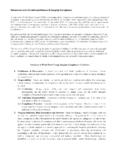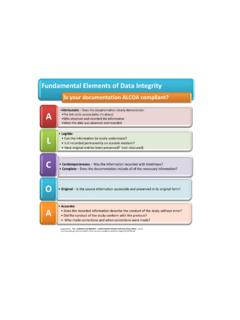Transcription of The bright and dark sides of leader traits: A review and ...
1 The Leadership Quarterly 20 (2009) 855 875. Contents lists available at ScienceDirect The Leadership Quarterly j o u r n a l h o m e p a g e : w w w. e l s ev i e r. c o m / l o c a t e / l e a q u a The bright and dark sides of leader traits: A review and theoretical extension of the leader trait paradigm Timothy A. Judge a, , Ronald F. Piccolo b, Tomek Kosalka c a University of Florida, United States b Rollins College, United States c University of Central Florida, United States a r t i c l e i n f o a b s t r a c t Keywords: The leader trait perspective is perhaps the most venerable intellectual tradition in leadership Leadership research. Despite its early prominence in leadership research, it quickly fell out of favor among Personality leadership scholars. Thus, despite recent empirical support for the perspective, conceptual work in leader trait the area lags behind other theoretical perspectives. Accordingly, the present review attempts to place the leader trait perspective in the context of supporting intellectual traditions, including evolutionary psychology and behavioral genetics.
2 We present a conceptual model that considers the source of leader traits, mediators and moderators of their effects on leader emergence and leadership effectiveness, and distinguish between perceived and actual leadership effectiveness. We consider both the positive and negative effects of speci c bright side personality traits: the Big Five traits, core self-evaluations, intelligence, and charisma. We also consider the positive and negative effects of dark side leader traits: Narcissism, hubris, dominance, and Machiavellianism. 2009 Elsevier Inc. All rights reserved. If one sought to nd singular conditions that existed across species, one might nd few universals. One universal that does exist, at least those species that have brains and nervous systems, is leadership. From insects to reptiles to mammals, leadership exists as surely as collective activity exists. There is the queen bee, and there is the alpha male. Though the centrality of leadership may vary by species (it seems more important to mammals than, say, to avians and reptiles), it is fair to surmise that whenever there is social activity, a social structure develops, and one (perhaps the) de ning characteristic of that structure is the emergence of a leader or leaders .
3 The universality of leadership, however, does not deny the importance of individual differences indeed the emergence of leadership itself is proof of individual differences. Moreover, even casual observation of animal (including human). collective behavior shows the existence of a leader . Among a herd of 100 cattle or a pride of 20 lions, one is able to detect a leadership structure (especially at times of eating, mating, and attack). One quickly wonders: What has caused this leadership structure to emerge? Why has one animal (the alpha) emerged to lead the collective? And how does this leadership cause this collective to ourish or founder? Given these questions, it is of no surprise that the earliest conceptions of leadership focused on individual differences. The most famous of these is Thomas Carlyle's great man theory, which argued, For, as I take it, Universal History, the history of what man has accomplished in this world, is at bottom the History of the Great Men who have worked here (Carlyle, 1840/2008, p.)
4 1). Despite its intuitive and presumably historical appeal, until recently, this great man (or woman) approach, and the trait perspective in general, fell on hard times. Reviewers of the literature commented that the approach was too simplistic (Conger & Kanungo, 1998, p. 38), futile (House & Aditya, 1997, p. 410), and even dangerous and a product of self-delusion (see Andersen, 2006, p. 1083).1. Corresponding author. E-mail addresses: .edu ( Judge), ( Piccolo), (T. Kosalka). 1. House and Aditya (1997) themselves did not espouse this viewpoint. Rather, they were summarizing what they perceived to be the prevailing sentiment in the leadership community. 1048-9843/$ see front matter 2009 Elsevier Inc. All rights reserved. 856 Judge et al. / The Leadership Quarterly 20 (2009) 855 875. As so often happens in intellectual affairs, however, as the obituaries were being written, the seeds of a reemergence were being sown. Personality theory, for many years fragmented by issues both pragmatic (how to measure personality) and philosophical (whether to focus on individual differences [nomothetics] or individual development [idiographics]), began to coalesce, at least to some degree, around a typology that provided both an organizing structure and a reasonable measurement approach.
5 This structure called the ve-factor model or the Big Five has been related to virtually all applied criteria ( , Barrick & Mount, 1991). Independently, meta-analyses of a diverse set of topics caused re-examination of many previously held assumptions in general, these meta-analyses showed that subjective eyeballing of data across studies generally leads reviewers to overestimate the variability in the data, and underestimate central tendencies. The intersection of these trends meta-analyses using the ve-factor model as an organizing framework has produced powerful insights into many if not most organizational behavior (see R. Hogan, 2005; Ones, Dilchert, Viswesvaran, & Judge, 2007). The leadership literature is no exception. In the most comprehensive meta-analysis to date, Judge, Bono, Ilies, and Gerhardt (2002) analyzed 222 correlations from 73 samples. They found that four of the Big Five traits had non-trivial correlations with leadership emergence and effectiveness: extraversion, conscientiousness, emotional stability, and openness to experience.
6 Together, the ve traits had a multiple correlation of R = .53 with leader emergence and R = .39 with leadership effectiveness. The gains revealed by the quantitative review notwithstanding, critics of the trait approach remain. First, some remain unimpressed by the size of the validity coef cients. In comparing the personality literature to an oft-cited, earlier review (Guion & Gottier, 1965), Murphy and Dzieweczynski (2005, p. 345) concluded, One major concern was that the validity of personality inventories as predictors of job performance and other organizationally relevant criteria seemed generally low. An examination of the current literature suggests that this concern is still a legitimate one. Andersen (2006, p. 1088). concluded: The main point is that the relationship (measured as correlation) is low. Consequently, personality has low explanatory and predictive power. Morgeson et al. (2007) went even further, arguing, among other things, that multiple correlations (between an entire Big Five typology and a criterion) are inappropriate, and that personality validities remain so poor as to cast doubt on their utility for Another, somewhat related, criticism of particular relevance to leadership is that while personality may reveal whether an individual is perceived as leader -like, personality is less than successful in identifying whether those leaders are successful in an objective sense.
7 Kaiser, Hogan, and Craig (2008) criticized the Judge, Bono et al. (2002) and Judge, Erez, Bono, & Thoresen, (2002). study for this (failed) distinction, noting, that the study focuses on how leaders are regarded and tells us little about leading effective teams or how such traits help organizations prosper (p. 102). Morgeson et al. (2007) also criticize the Judge, Bono et al. (2002) and Judge, Erez et al. (2002) meta-analysis on these grounds, arguing, Perceived in uence is not equivalent to effectiveness, and showing that there is a correlation of a personality dimension with perceived in uence does not provide a strong basis for use of this measure to select managers who will be effective (p. 1044). Though Judge, Bono et al. (2002) and Judge, Erez et al. (2002) did distinguish between leader emergence who is recognized as a leader of a group and leadership effectiveness how well that leader performs in that role, it is fair to conclude that most of the studies they cumulated for leadership effectiveness still relied on subjective Third, its growth and widespread acceptance notwithstanding, there remain general critics of the ve-factor model.
8 One prominent critic Block (1995, 2001) focused mostly on the inductive origins of the taxonomy, both statistically (limitations in the use of factor analysis) and methodologically (the input into the factor analysis, namely the lexical and questionnaire approaches). Another critic McAdams (1992) argued that the selection of ve factors is insuf ciently justi ed conceptually and empirically, that the ve traits are too broad to provide insights into many aspects of human behavior, and that they are decontextualized accounts of human nature. Further, the ve-factor model, based largely on results from studies conducted in Anglo-Germanic languages, has been criticized for not generalizing to other languages and cultures (Salgado, 1997). Another line of research, that while not necessarily standing in opposition to the ve-factor model, argues in favor of either fewer ( , Digman, 1997) or more ( , Benet-Martinez & Waller, 1997) core factors.
9 Goldberg, for example, despite being a strong advocate of the notion that the most salient individual differences become encoded in natural language ( , lexical hypothesis), favors a circumplex model of trait interactions (Abridged Big Five Dimensional Circumplex, AB5C; Hofstee, de Raad, &. Goldberg, 1992), whereby blends of the ve traits are treated as more valid indicators of personality than the otherwise distinct ve factors. Moreover, despite widespread use of the ve-factor model, including facets of subdimensions of these factors (see DeYoung, Quilty, & Peterson, 2007), there still is not widespread agreement on the lower-order facets. Finally, there are other trait perspectives that may be relevant to the topic at hand. For example, Gray's (Gray, 1990; Pickering & Gray, 1999) Reinforcement Sensitivity Theory, with its emphasis on the Behavioral Approach/Behavioral Inhibition System (BAS/BIS), might be argued to be particularly relevant to the leader trait paradigm.
10 There is some evidence that these approaches share similarities: BAS is linked to high levels of extraversion, and BIS to high levels of neuroticism (Smits & Boeck, 2006). The choice of one framework does not dismiss the potential utility of another. We rely largely on the ve-factor model because it has 2. Our mention of these arguments should not be construed as an endorsement. The criticisms are, we believe, somewhat one-sided, unduly harsh, and not representative of most scholars' views. Nevertheless, they are relevant to an appraisal of the leader trait approach, and guide the current effort in some sense. 3. Objective measures of leadership effectiveness have problems of their own, of course. They may be badly contaminated by extraneous in uences, and often present causal inference problems that may be as serious as those underlying subjective appraisals. A correlational analysis relating leader traits (say, of Presidents) to objective outcomes (American economic and foreign policy performance) is generally full of judgment calls and subjective appraisals of its own, no matter how well considered and conducted (see House, Spangler, & Woycke, 1991).








